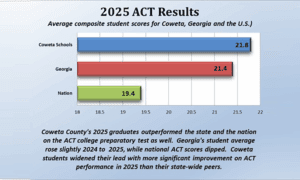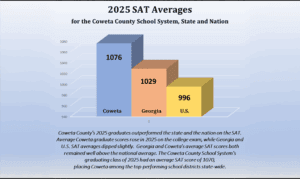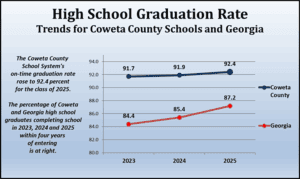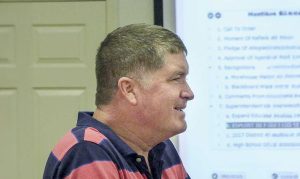New federal requirements are said to have impacted the findings that led to 22 of Coweta County’s 28 schools achieving Adequate Yearly Progress (AYP) in 2011. The six schools not reaching that bar centered on issues relating to scores on CRCT (Criterion Referenced Competency Test) math tests, graduation tests and graduation rates.
School system spokesman Dean Jackson said this year’s local results followed state and national trends where 22 of Coweta’s 28 schools made AYP in 2011, while six did not. By comparison, all Coweta County schools made Adequate Yearly Progress (AYP) in 2009, and only one did not make AYP in 2010, Jackson said.
Following a significant 2011 increase in the minimum measures of the No Child Left Behind Act (NCLB), 37 percent of Georgia schools did not make “Adequate Yearly Progress.” Seventy percent of all Georgia high schools did not make Adequate Yearly Progress in 2011 under the rising passage and graduation rates required under the federal law, said Jackson.
According to the Georgia Department of Education’s annual AYP report East Coweta, Newnan and Northgate High School, Lee Middle School, Poplar Road and Ruth Hill Elementary Schools did not make AYP in 2011, Jackson said.
Ruth Hill and Lee Middle School are expected to make AYP when test passage rates are re-calculated this September using students’ re-test scores on the Georgia CRCT.
The No Child Left Behind Act (NCLB) was developed to encourage uniformly high curriculum standards and to establish a method of accountability for each school and school district. Schools are required to meet required pass rates on high stakes tests in English and math, and must meet requirements set for test participation and either attendance (in elementary and middle grades) or graduation rate (in high schools).
Under NCLB, the required success rate is called the annual measurable objective (AMO). Meeting this requirement is sometimes called “making the bar.” The requirement is a measurement applied to groups of students rather than to individual student performance.
To make AYP, every school must meet the bar in its overall school population and in a number of student subgroups. Under current legislation, the bar rises each year for all schools until, by 2014, 100 percent of students must pass math and English tests, meet other academic requirements and graduate.
For example, said Jackson, high school graduation rates (for the overall population and subgroups within the school) had to exceed 80 percent in 2010 to make AYP. Those rates rose to 85 percent in 2011. Required graduation rates rise to 90 percent percent next year, and to 100 percent by 2014.
Required math passage rates for high schools also rose this year, for all students and subgroups, from 67.6 percent last year to 75.7 percent this year. They rise to 83.8 percent next year and to 100 percent by 2014.
Jackson said that in many cases in Coweta County, schools would have made AYP under last year’s passage rates but did not make it because the bar was raised for 2011. In most cases, Coweta schools not making AYP in 2011 met the bar among students overall, but did not make AYP because of performance within one or more subgroups.
Coweta Schools not making AYP included:
·East Coweta High School – Did not make AYP because of subgroup passage rates for math and English/Language Arts graduation tests and overall graduation rate.
·Newnan High School – Did not make AYP because of overall graduation rate.
·Northgate High School – Did not make AYP because of subgroup passage rates for English/Language Arts graduation tests. Overall school population met AYP bar, and may make AYP under recalculated scores.
·Lee Middle School – Did not make AYP because of subgroup passage rates on CRCT math. Overall school population met AYP bar, and the school should make AYP under recalculated scores.
·Ruth Hill Elementary School – Did not make AYP because of subgroup passage rates on CRCT math. Overall school population met AYP bar, and the school should make AYP under recalculated scores.
·Poplar Road Elementary School – Did not make AYP because of subgroup passage rates on CRCT math. Overall school population met AYP bar.
Jackson said because 2010-2011 is the second year that Newnan High School did not meet AYP, the school will be listed as a “Needs Improvement” school. This will result in additional services offered to students. More information about those services will be forthcoming.
The Coweta County School System did not make AYP as a system because of the graduation rate of the system’s overall population and among some subgroups. The system-wide graduation rate was 80.6 percent for 2011, while the AYP performance bar rose to an 85 percent graduation rate in 2011.
“Coweta’s performance under NCLB in 2011 reflects state and nation-wide trends. Because of rising performance criteria, schools that do well or make significant gains in one year can still not make AYP. Newnan High School, for example, saw an increase in math Graduation Test passage rates from 2010 to 2011 (94 percent of students overall passed the graduation math test in 2011, up from 74.7 percent in 2010). The school as a whole, and all subgroups, met NCLB academic standards in 2011, but did not meet graduation rates under the 2011 bar,” Jackson said.
Jackson said that with continuously rising bars for all subgroups, high schools also tend to be affected before other schools. Coweta’s three high schools have larger student populations than its elementary schools, so they have a greater AYP challenge. Middle schools also face the challenge of large testing groups, because all middle school students test.
For high schools, and for school systems as a whole, calculation of graduation rate also poses a higher risk for schools to be labeled as not making AYP. Students who might need more than four years and one summer semester to graduate can complete their education with a high school diploma.
However, these students do not count as graduates. They are calculated as dropouts for the purposes of AYP/NCLB, Jackson said.
Students on Special Education diplomas are not counted as graduates, even though they might have met and exceeded their Individual Education Plan goals. Students who successfully earn the 28 required credits to earn a diploma but who have not passed all five graduation tests also do not count as graduates. They are calculated as dropouts.
To address these difficulties, educators in Coweta County are working diligently to provide opportunities for student success. Credit recovery programs and remediation are being offered before school, after school, and at lunch. Staff members are involved in professional development, and numerous research-based teaching methods are being employed in classrooms. However, because of the rising bar of high stakes testing as a measure, a school may receive a negative label even when students are being more successful than ever before, Jackson said.
As a result of the many challenges created by NCLB, the Georgia High School Graduation Test will no longer be used for AYP determination after the 2010-2011 school year. This test, administered to juniors, is two years removed from much of the content that is taught during the freshman year. Beginning next year, specific End of Course Tests will be used to calculate AYP.
The Georgia Department of Education, education agencies from other states, and U.S. Secretary of Education Arne Duncan, have said that current NCLB legislation is in need of adjustment. Secretary Duncan has said that he is prepared to give public schools relief from federal mandates under NCLB if Congress does not pass the law’s long-awaited overhaul and reauthorization, which is four-years overdue, according to Duncan. Duncan has warned that as many as 83 percent of U.S. schools could be labeled as failing next year based on current NCLB rules.












Leave a Comment
You must be logged in to post a comment.